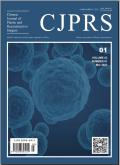游离 PAP 瓣乳房重建中的挽救性吻合:游离皮瓣新生血管怎么办?
Chinese Journal of Plastic and Reconstructive Surgery
Pub Date : 2023-12-01
DOI:10.1016/j.cjprs.2023.12.001
引用次数: 0
摘要
自显微外科在重建手术中出现以来,游离皮瓣已成为乳腺癌患者治疗的关键工具。其中一个皮瓣是深动脉穿支(PAP)皮瓣。迄今为止,没有科学共识的体积自由皮瓣是否仍然依赖于血管蒂在其整个生命周期。因此,翻修手术时应小心保护椎弓根。在这篇文章中,我们回顾了一个中年妇女在自由皮瓣乳房重建六个月后的翻修手术中遭受椎弓根横断需要重新吻合的病例。一名52岁女性因右乳及腋窝有一硬结节而转介至我科接受手术治疗。该高加索妇女首次就诊时无明显病史或症状。超声引导下活检证实为浸润性III级小叶癌。根据分期,患者在右侧乳房切除术前接受了新辅助化疗,并进行了完全的同侧腋窝淋巴结清扫和术后放疗。放疗结束一年后,采用PAP皮瓣进行自由皮瓣重建,6个月后,需要进行翻修手术,用组织扩张器增加重建乳房的体积,然后植入。不幸的是,翻修手术中发生了蒂横断,导致皮瓣完全断流,术中吲哚菁绿成像证实了这一点。作者选择术中行挽救性再吻合。根据作者23年自由皮瓣的经验,血管蒂应始终保留在大体积的自由皮瓣中,因为单独的新生血管可能无法确保整个皮瓣的存活。作者建议,如果在翻修手术中血管受损,总是尝试再吻合。本文章由计算机程序翻译,如有差异,请以英文原文为准。
Salvage anastomosis in free PAP-flap breast reconstruction: What about free flap neovascularization?
Since the emergence of microsurgery in reconstructive surgery, free flaps have become a key tool in the management of patients with breast cancer. One such flap is the profunda artery perforator (PAP) flap. To date, there is no scientific consensus on whether voluminous free flaps remain dependent on their vascular pedicle throughout their lifespan. Therefore, the pedicle should always be carefully protected during revision surgery. In this article, we review the case of a middle-aged woman who suffered a pedicle transection needing re-anastomosis during revision surgery six months after free-flap breast reconstruction. A 52-year-old woman who noticed a firm nodule in her right breast and armpit was referred to our department for surgical management. The Caucasian woman presented with no significant medical history or symptoms at the first consultation. Ultrasound-guided biopsy confirmed an invasive grade III lobular carcinoma. Following staging, the patient underwent neoadjuvant chemotherapy before a right mastectomy with a complete homolateral axillary lymph node dissection and postoperative radiotherapy. One year after completing radiotherapy, free flap reconstruction with a PAP flap was performed, and six months later, revision surgery was required to enhance the volume of the reconstructed breast with a tissue expander and later an implant. Unfortunately, pedicle transection occurred during revision surgery, causing complete devascularization of the flap, which was confirmed by intraoperative Indocyanine Green imaging. The authors elected to perform salvage re-anastomosis during the surgery. In keeping with the author’s 23-year experience with free flaps, the vascular pedicle should always be preserved in voluminous free flaps, as neovascularization alone may not ensure whole flap survival. The authors suggest always attempting re-anastomosis if vessels are compromised during revision surgery.
求助全文
通过发布文献求助,成功后即可免费获取论文全文。
去求助
来源期刊

Chinese Journal of Plastic and Reconstructive Surgery
Surgery, Otorhinolaryngology and Facial Plastic Surgery, Pathology and Medical Technology, Transplantation
CiteScore
0.40
自引率
0.00%
发文量
115
审稿时长
55 days
 求助内容:
求助内容: 应助结果提醒方式:
应助结果提醒方式:


